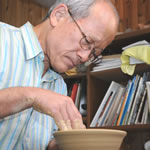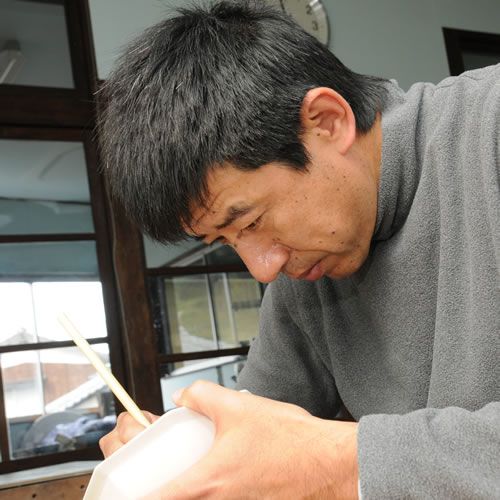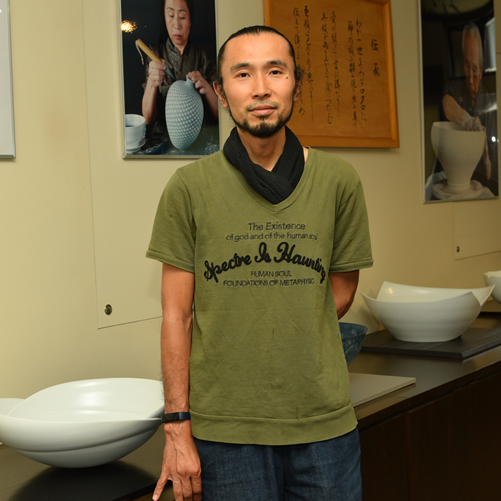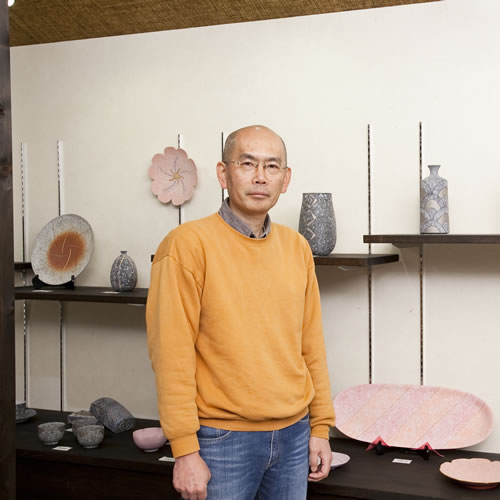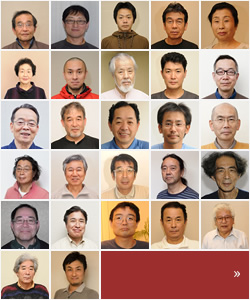Karatsu Ware
Ceramics in the Hida area of Kyushu and specification by Traditional Crafts Japan
Karatsu Ware is the pottery to be fired in the Hizen area of Saga prefecture and Nagasaki prefecture. In the beginning of Karatsu Ware, cloudy straw ashes glaze was used frequently. It was called "Kishidake area Karatsu" and distributed to the western area until the Kansai region, the Sea of Japan side in the eastern Japan though it was small amount. That was in Tensho and Bunroku era from 1580 to 1590's. In 1603, the Karatsu Mizusashi was seen in Oribechakaiki (record for tea ceremony) and tea bowls which was fired by Korean potters in Saga were shown in the various tea ceremony. The artifacts from the ruins of a kiln tell us the mass production of the bowls, plates, etc. in addition to these tea utensils at that time. Karatsu Ware confronted Mino Seto Ware's glazed pottery since Middle Age, and grew to divide ceramics markets of the whole country into two parts. While Matsuura group who showed the prosperity went to Korea and back to Japan, they took one Korean potters and made them start producing pottery.
The technique of Kishidake course pottery kiln is divided into two groups. One is the group for making the bowls or the plates by the potter's wheel, and the other is the group for making jars, vases, bottles, bowls by Tataki (beating). It is the structure of the climbing kiln which utilizes mountain's slope which was never seen in Japan, and it was called Waridake system. The several separate firing rooms are lined up by the partition walls. This Kishidake course kiln lost the guardian since the lord HATA was discharged by TOYOTOMI, Hideyoshi in 1594. Therefore, these kilns disappeared gradually, and moved to Imari or Takeo in the southern part of Saga prefecture. The characteristic of the pottery in this period were Tetsue (underglaze iron decoration) or Egaratsu (Karatsu Picture design) as the symbol of Karatsu Ware.
From the 1600s, the production of Tetsue decreased rapidly. On behalf of it, Katakamizuri (printing by paper pattern) used the white engobe appeared.Misimade filled with the white clay, and Nisaide which was expressed and glazed with the new appeared two colors of Doryokuyu (copper green glaze) and Iron painting were started. Then, the flavor was different from the Karatsu Ware in Momoyama period, the time of what is called "Nisaide" or "Mishima Karatsu" which has strong and confident design arrived. From its simple flavor, the Karatsu Ware in Edo period is evaluated as the representative arts of Mingei (folk craft) by YANAGI, Muneyoshi. Being equal to Imari Ware at that time, Karatsu Ware had the large market in Japan and recently it turned out that it had been exported to foreign countries beyond the recognition as the folk kiln. Karatasu Ware had a good reputation all over the country, many offerings to Edo shogunate, it was called "Kenjo Karatsu". But after the Meiji Restoration, Karatsu Ware lost the clan's patronage, and the number of kilns which canceled production increased, they doubted whether it continued. MIZOKAMI, Sofu who succeeds the traditional kogaratsu technique and paints the fantastic image on the vessels leisurely devotes to create pottery of original Karatsu. Karatsu Ware are broadly classified, Egaratsu, Mujikaratsu, Chosengaratsu, Madarakaratsu, Kushimekaratsu, Suriekaratsu, Mishimakaratsu, Kohiki, Okukorai, Aogaratsu, Kigaratsu, Hakemekaratsu, Horigaratsu, Horinotekaratsu, Nisaikaratsu and so on. Karatsu has prospered in the trade, and the production method of the pottery introduced from China in Azuchimomoyama period. It is called Karatsu Ware since the origin of the ceramic which was shipped from Karatsu port. The tableware made in the beginning expressed the spirit of simplicity and wabi ("tranquility") which is already the characteristic of the Karatsu Ware. Karatsu Ware became widely known as the masterpiece of the tea ceremony and masters of the tea ceremony rated them as "first Raku, second Hagi, third Karatsu". There are still many ruins of a kiln now.
Karatsu Ware was made by the kicking potter’s wheel and the climbing kiln those are the technique introduced into Karatsu long time ago. It had a good reputation as tea-things once. It is still popular as the pottery that is expressed very simply and deeply today.

